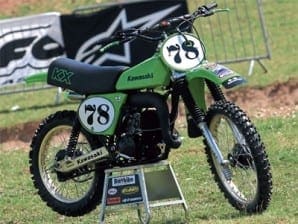
There’s a great deal of satisfaction gained from rebuilding a bike, but if you don’t ride it afterwards then what has all the work been for?
This is what sets those in the dirt bike world apart from other restorers. Take the recent off-road show at Telford, there were any number of great looking bikes that, to coin the phrase, ‘you could eat your dinner off’. Their owners all had the same thing to say… “I can’t wait to get it dirty.”
For roofer Martin Bateson it took quite a while to ‘get it dirty’, 16 years in fact. Martin takes up the story…
In the beginning
For me the start of this 125 A4 project happened by accident when, in 1993 I was working on the roof of a house in Surrey near where I used to live. Being so high up I could see into quite a few gardens and noticed in the one opposite the house I was working on, actually owned by an old neighbour of mine, was the Kawasaki he used to ride in the 80s. Stuck out in the elements and propped up with a milk crate, as the front wheel was elsewhere, it seemed a shame to leave it there to rot.
At lunch time I wandered over, knocked on the guy’s door and asked if he was interested in selling the bike? The answer couldn’t have been better. He told me that I would be doing him a big favour if I wanted to take the bike away. It turns out his dad was giving him some grief to get rid of it. I offered £20 on condition that the front wheel was still around. My old neighbour rummaged in the garden shed, found the wheel, I handed over the £20 and the bike was mine.
The wheel had been removed because of a puncture that the chap hadn’t got round to repairing and in consequence the bike hadn’t moved in 10 years.
Sadly the mudguard, number plate oval and the rest of the plastics and rubber had perished in that time. In fact the whole bike was a mess but certainly worth £20.
Waited a while
The bike came home with me that day and was stored it in my garage while I got on with rebuilding my 1985 KX500. In the end it stayed untouched for the next 16 years as I was busy building up our family roofing business, getting married and starting a family and all those other demands on time and funds that go with life so had neither spare time or cash to make a start on it.
In 2009 though, I hit 40 and with the business well established and my children much older I had the time and enthusiasm to think about starting a rebuild on the Kawasaki.
Initially I just wanted to get it running and be able to ride it round the local track on occasions. It went a little bit further than that though. But, first things first, getting the Kawasaki into a position where I could look at it and check it over was a revelation and a realisation on just how far gone this bike was.
Each inspection of the bike almost filled a notepad with a list of things missing. Things such as cables, back brake pedal, air duct and, well, you get the picture. I was fortunate to find a parts manual for the bike on the internet, which gave every part number of every nut and bolt and all other major parts for the bike. A manual like this is invaluable and made it far easier to track down parts and order online.
Longstanding Kawasaki dealers were high on the list to contact and a very useful one proved to be Brian at Corby Kawasaki, Northants. When I spoke to him about the bike and getting it going, he told me just how rare the 1978 A4 model was, with only 40 coming into the UK that year. He added that parts were scarce.
Suddenly the focus of the project had changed and it was then that I realised it would be worthwhile investing some money into restoring the bike to its former glory.
Seek and ye shall find
Brian searched the spares stores at Corby Kawasaki and gave me a list of all the spares he had left for this model. Yes, of course I bought them all and only gulped once at the asking price.
The cache of spares was incredible, with things like an original pair of crank cases – listed at over £400 when new – plus various nuts and bolts, ignition coil, original chain and sprockets. This meant the rebuild was off to a flying start, though not all the parts I wanted were there. However, up in Lancashire, there is another longstanding dealer called Doug Hacking Motorcycles. Caroline at the Bolton-based company was more than helpful in tracking down a chain guide, kickstart, brake shoes, piston and ring. So I could go on to the next stage.
As we go through life we build up a circle of friends, often with common interests to ourselves. It is inevitable that in this circle will be friends who can ‘do’ things, things like blasting and powder coating.
One such friend for me is Ian Clements who took away the grotty frame and handlebars after I’d completely stripped the Kawasaki and returned them all shiny and black. He also fabricated a new rear tailpipe for the exhaust system as an original was no longer available.
One of the most frustrating parts to locate and one that proved to be unobtainable was the missing air duct. Despite many hours contacting enthusiasts all over the world no one could supply one. Sod’s Law will kick in now and after reading this, someone close to me will have a box full. Without Ian’s fabricating skills the job would have stopped.
Runnymede Motocross Track at Virginia Water is run by 1980 GP KTM 500 rider Russ Jarman who I’ve known since I was fifteen, when I used to bunk off school on a Wednesday morning and watch him ride over the Old Dean Common with world champ Dave Thorpe. He’s a pretty handy suspension guy so I dropped the front end off with him and let him do what was needed. The forks were in good condition generally and had not seen much use so a service and new seals was all that had to be done.
Drive time
When it came to the engine needing a rebuild, I decided the best course of action was to give the whole engine to Corby Kawasaki and let them strip it and rebuild it as they would have all the parts to hand.
As it is a two hour drive to Corby it seemed sensible to take the wheels – so Corby Kawasaki could rebuild them – as well as the engine. As the wheels were there it made sense to have new tyres and tubes put on too, after all, the old ones were beyond help. I had Corby Kawasaki use the new crankcases for the rebuild and I spent time spraying the head, barrel and side cases with PJ1 satin black paint to match them.
There is a bit of polished alloy to see on the KX125 and this was cleaned up, by me, using the Solvol Autosol and wire wool method and I’m sure the black will come out of my fingers eventually…
The rear shock absorbers were too far gone and beyond repair. I initially wanted to buy a set of Fox or Ohlins but the quotes for these were around the £1000 mark – way beyond my budget. Brian at Corby Kawasaki managed to track down a set of Hagon shocks for £120 which he advised were just the job.
The resurrection
With all the component parts back from their servicing or repair the ‘Grand Day of the Rebuild’ arrived. Luckily I’d managed to find a genuine service manual in the US and as it listed the location of every nut, washer, bolt, spacer and part it made the whole job much easier.
On the whole, the rebuild was fairly straightforward and went well. The only hiccup was the plastics, those that hadn’t rotted or perished that is. No matter how much cleaning and polishing they weren’t coming up well and were letting down the look of the bike.
Nightmare Racing, based in the US, specialises in reproducing plastic kits for Kawasaki bikes, so I ordered a complete set including KX 125 side stickers. These are of great quality, high gloss and correct colour and fit the bike beautifully and well worth the extra expense.
For the final finishing touches, I got hold of some Doherty grips to match the Doherty throttle and keep the bike looking period. I also bought a new seat cover from www.MXM.co.uk which I found in the pages of CDB magazine, they also came up with some 70s style stickers and retro Kawasaki race shirt. At this time – the late 70s – the world had shrugged off the plan looks of the previous decades and manufacturers could shamelessly shout about who’s chucked a quid or two into the team. They did this by placing stickers over the team bikes and the production models got them too. So, the number plate stickers, front fork and swinging arm stickers were reproduced by Mark Payne of Signspeed.
Mint condition
The bike is in mint condition but it has been built to ride and that’s exactly what I do every Saturday over at the Runnymede Motocross Club. It draws much attention from all riders, of those racing ‘in the day’, many mistaking it for an A5 1979, so rare was the A4 in its day, and most say it should be on display in a museum and not out on the track.
But there’s no fun in a static exhibit and it is a real pleasure to ride and takes me back to my youth in 1979 when I had a KX250. It is the best feeling in the world to blast out with the front wheel slightly up and two-stroke engine screaming!
My total spend for this project is just over £3000, the cost of the bike new in 1978 would have been £900. but it’s priceless to me and will never be sold. ![]()




